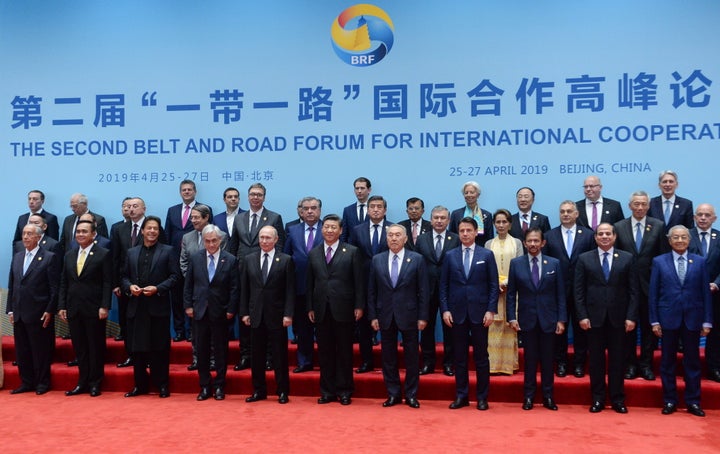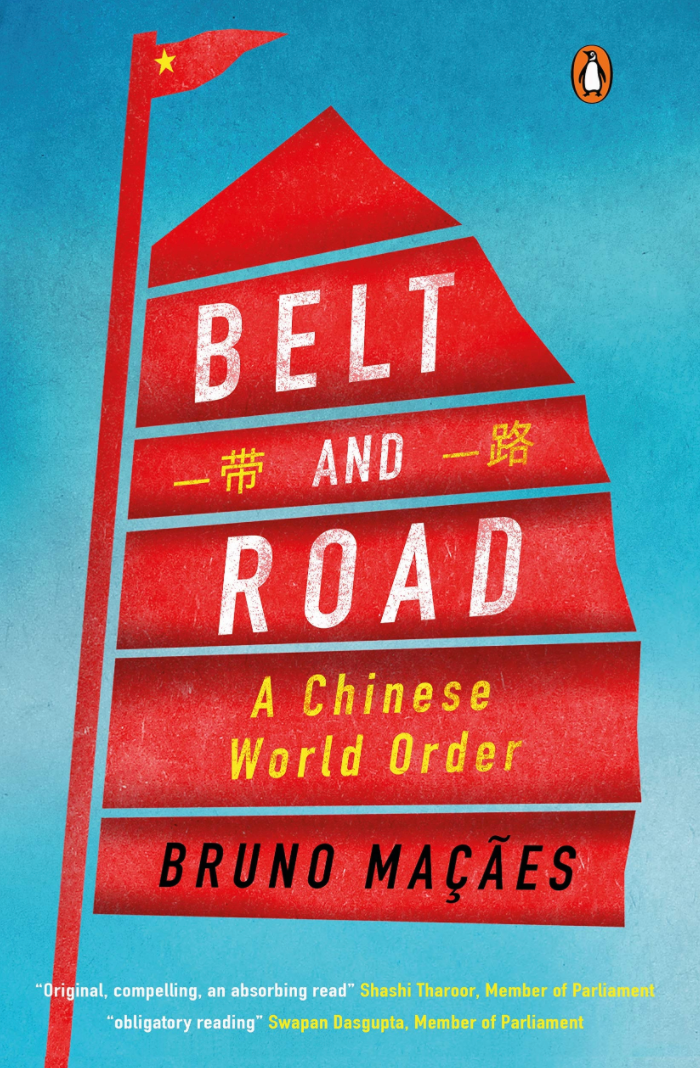
With several projects under China’s Belt and Road Initiative affected due to the Covid-19 pandemic and partner countries asking for debt relief, questions have been raised over the future of Xi Jinping’s ambitious project announced in 2013.
Egypt indefinitely postponed construction of a coal-fired power plant at Hamrawein in February. In May, Nigeria decided to set up an investigation committee to review the loan agreements between China and Nigeria, according to reports.
Bruno Macaes, a non-resident senior fellow at the Hudson Institute and former Europe minister of Portugal, told HuffPost India in an interview that while Covid will create some short-term problems for the Belt and Road, it can also open up new opportunities.
The global recession will reduce prices of assets that China might be interested in acquiring, but loan repayments will become more difficult, he explained.
In his book Belt and Road: A Chinese World Order, published by Penguin, Macaes said India’s rejection of the Belt and Road may have triggered the Doklam standoff in 2017. He pointed out that there is a connection between the border developments both in Doklam and now in Galwan and the Belt and Road.
“I think China is trying to show the Indian government that there is a price to pay if you oppose the Belt and Road — a price to pay at the border and in terms of aggressive military posture.”
China still appears optimistic about the Belt and Road and the former People’s Bank of China chief has called Covid just a “blip” in the plan. Do you think the future of the project is still safe or will it face major setbacks now?
The main obstacle has been the increasing political resistance to the project. We saw it in Europe and Southeast Asia. I think it started with India back in 2017 when New Delhi decided not to join the Belt and Road forum. Since then, many other countries have been showing doubts or resistance to the initiative. That’s the main problem China has had to deal with.
Covid will create some short-term problems, but it can also open up some opportunities. The global recession or depression will reduce prices of assets that China might be interested in acquiring. That’s an important part of Belt and Road. Covid might make these things easier, but it might make other things — like loan repayments by countries — even more difficult.
I really don’t think the main issue is Covid, the main issue is that China has not been able to come up with a political strategy to promote the Belt and Road. When the initiative is successful, it’s because of the economic opportunities it offers, but there’s a lot of political resistance that China does not seem to have any strategy to deal with.
China has agreed to write off loans of African nations. Some other countries have also asked to defer payments or restructure loans from China. With its own economy struggling, can China afford to do so? Will there be a backlash from the domestic audience?
Loan repayment isn’t the main issue because they are not that significant from the point of view of Chinese financial system. China has, in many cases, contracted some collateral in case loans are not repaid and it may find itself in a position where it will acquire infrastructure in some parts of the world.
We see some problems with the Chinese economy right now — like the trade war with US is a big threat and China’s dependence on exports and also access to technology because China is self-sufficient in some technological areas but not in others. Countries that China needs as partners for technological development, like the US and Japan, are in one way or the other turning against China.
Belt and Road is a drop in the ocean in terms of the size of the Chinese economy and should not be a big problem.
You say in the book that when participant countries are unable to pay back these loans, Beijing offers to swap debt for equity. Will China risk its global reputation by doing so in the midst of a pandemic?
Swapping debt for equity is a way for the Chinese to acquire infrastructure ports. It’s very obvious that China risks its reputation. UK just reversed its position on Huawei and the pandemic was the main factor. While there are some concerns that China was very secretive and not upfront about Covid in January, there is a sense in Europe that China tried to take advantage of the pandemic for geopolitical gains and this was very badly received in Europe. I consider it a major blunder of China’s foreign policy. They had an opportunity to present China as a model of how to respond to the pandemic, but they were very aggressive in trying to promote the China model and trying to take advantage of the failure in Europe.
For many in Europe, it was a wake up call of how competitive and aggressive China can be. I think it was more about how China tried to take advantage of the pandemic than the fact that it originated in China.
Belt and Road, as you have mentioned in your book, represents the slow expansion of Chinese influence and is looked at as a project of Chinese expansionism. China has now become more aggressive in its territorial claims and the US at least has spoken about China’s bullying. Do you think Belt and Road can now face a challenge from any other country?
With Barack Obama, the US policy was of ignoring the Belt and Road. The policy changed with the Donald Trump administration and became a policy of actively trying to oppose, contain and undermine the Belt and Road. Some parts of the US response have been successful. It does look like the US attempts to stop Huawei from becoming a leading telecommunications company are being successful.
The US has still not offered an alternative though. Many countries, particularly in Africa and Southeast Asia, don’t have any alternative to the Belt and Road. Djibouti needs infrastructure and China is the only country present there. US and Europe are not present. India also has the opportunity to offer an alternative to the Belt and Road, but it’s still struggling with the demands that such a project would have, both economical and political.
I don’t think it’s enough to just create obstacles for the Belt and Road, these countries have to offer an alternative.
You mentioned the various actions China has taken since 2018 to change India’s stance towards Belt and Road. This includes staying neutral when Pakistan was put on the terror financing grey list and proposing the building of an economic corridor between India, China and Nepal. Considering the recent tensions between the two countries, do you think India will ever look at Belt and Road favourably?
China did not take India seriously when the Belt and Road was launched. It took Russia seriously and was able to make Moscow a part of the project. China just assumed that India would be forced to join and it would have no alternative if its neighbours join. This was a mistake of China’s foreign policy, but that was the logic then. Even today, this seems to be a very popular opinion in Beijing.
India actually turned against the initiative because China did not take the possibility of India’s opposition seriously. India has decided to move against the Belt and Road and China is now retaliating against India. There is a connection between the border developments both in Doklam and now in Galwan and the Belt and Road. I think China is trying to show the Indian government that there is a price to pay if you oppose the Belt and Road — a price to pay at the border, in terms of aggressive military posture. This could also move to other regions. It’s entirely possible that there can be problems in the Bhutan area again or Indian Ocean in the future.
Relations between India and China are on a downward path and I think it started after China took a dismissive view of India’s influence.
Are you saying that the standoff in Ladakh is possibly a consequence of India’s reluctance to join Belt and Road?
Belt and Road is not just about infrastructure, it is about economic development and integration. At the beginning of the pandemic, people in India were saying that New Delhi had the opportunity to attract industry from Beijing because China was having problems with the pandemic and was engaged in a trade war with the US. This was regarded in Beijing as a direct threat to Chinese economic power and a direct threat to the Belt and Road.
There is a direct connection between the sense that India could become a rival to Chinese economic power and what’s happening in Ladakh. You can see that these two things are connected because India’s response has been less about the border and more about the economy and technology, which is at the core of Belt and Road. The main element of India’s response was the ban on 59 Chinese apps. This shows that there’s a connection between the border situation and the economic and technological competition between China and India.
(Ed—Manohar Lal Khattar said in May that Haryana has chalked out an aggressive strategy to woo the investments and companies intending to either shift from China or setting up of a new manufacturing facility in India.)
You speak about the importance of Xinjiang in the Belt and Road in your book. Aksai Chin provides connectivity between Xinjiang and Tibet. Do you think China’s actions along the Line of Actual Control can be traced back to Union minister Amit Shah’s statement that Aksai Chin is part of Jammu and Kashmir?
There is a connection between Belt and Road and what is happening in Xinjiang for many years. The situation worsened in 2016. China wants to transform Xinjiang into an economic corridor linking to central Asia and to Pakistan. From the Indian point of view, this is a very delicate issue. It could turn the Kashmir situation into a fait accompli and impossible to resolve because of strong Chinese presence.
Russia’s foreign minister skipped the virtual conference on the Belt and Road last month. What do you think is Russia’s stand with respect to Belt and Road?
Russia is being very careful not to oppose the Belt and Road. This does not mean Russia has embraced it. It continues to pose some obstacles and limitations to Chinese investment inside Russia because it knows that Chinese economic power can very quickly become dominance. Russia does not have much access to investment from Europe or US, if it opens the door to Chinese investment, it’s entirely possible that large sectors of the Chinese economy will be quickly controlled by China. Russia has been careful, but its position has essentially been supportive of Belt and Road. This is because Russia thinks its main threat comes from the West and it’s better for Russia if China and US are at competing poles. Perhaps it even thinks that if China and US get engaged in an economic war then Russia can benefit from that.
